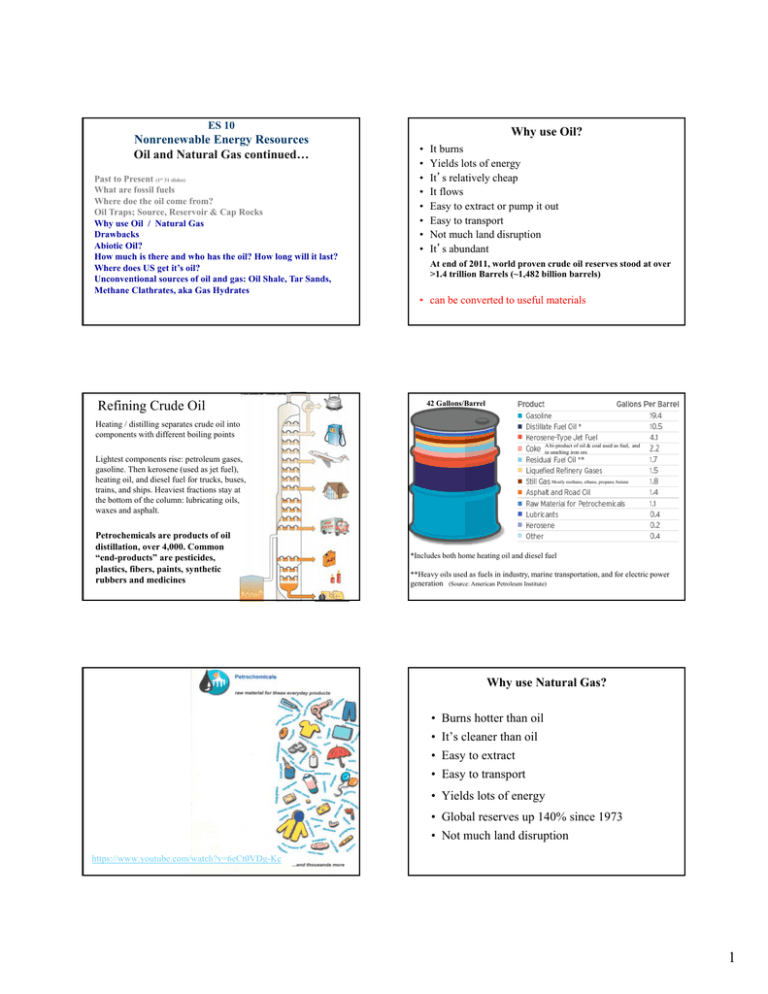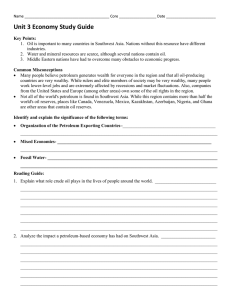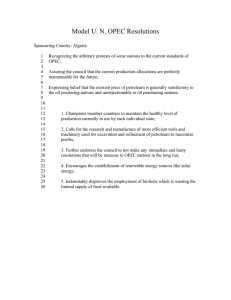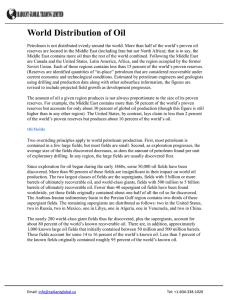Nonrenewable Energy Resources Oil and Natural Gas continued… Why use Oil? ES 10
advertisement

ES 10 Nonrenewable Energy Resources Oil and Natural Gas continued… Past to Present (1 31 slides) What are fossil fuels Where doe the oil come from? Oil Traps; Source, Reservoir & Cap Rocks Why use Oil / Natural Gas Drawbacks Abiotic Oil? How much is there and who has the oil? How long will it last? Where does US get it’s oil? Unconventional sources of oil and gas: Oil Shale, Tar Sands, Methane Clathrates, aka Gas Hydrates st Why use Oil? • • • • • • • • It burns Yields lots of energy It’s relatively cheap It flows Easy to extract or pump it out Easy to transport Not much land disruption It’s abundant At end of 2011, world proven crude oil reserves stood at over >1.4 trillion Barrels (~1,482 billion barrels) 1,481,526 • can be converted to useful materials Refining Crude Oil 42 Gallons/Barrel Heating / distilling separates crude oil into components with different boiling points A bi-product of oil & coal used as fuel, and in smelting iron ore Lightest components rise: petroleum gases, gasoline. Then kerosene (used as jet fuel), heating oil, and diesel fuel for trucks, buses, trains, and ships. Heaviest fractions stay at the bottom of the column: lubricating oils, waxes and asphalt. Petrochemicals are products of oil distillation, over 4,000. Common “end-products” are pesticides, plastics, fibers, paints, synthetic rubbers and medicines Mostly methane, ethane, propane, butane *Includes both home heating oil and diesel fuel **Heavy oils used as fuels in industry, marine transportation, and for electric power generation (Source: American Petroleum Institute) Why use Natural Gas? • Burns hotter than oil • It’s cleaner than oil • Easy to extract • Easy to transport • Yields lots of energy • Global reserves up 140% since 1973 • Not much land disruption https://www.youtube.com/watch?v=6eCt0VDg-Kc 1 Disadvantages of using Oil & Natural Gas? • Often degrades fresh air, soil and water • Emits greenhouse gases (CO2, CH4) and other damaging gases (CO, NOx, SOx, H2S) The semi-submersible rig Deepwater Horizon, drilled the Tiber well in the Gulf of Mexico. Water depth = 4,132 ft or 1,259 meters. Total depth of well ~35,055ft or ~10.7km or ~6.6 miles, deepest well in history. Could yield 400,000 – 650,000 bpd September, 2009 • Gases contributes to global climate change http://www.cabrillo.edu/~rnolthenius/climate/index.html • Causes acid deposition • Can be explosive • Not much time left at current rate of use • Damaging leaks, spills and runoff are common in the world’s oceans…. An explosion on 4/20/10 killed eleven crewmen. On 4/22/10 Deepwater Horizon sank, leaving its well gushing causing the largest offshore oil spill in the history of the petroleum industry. April 20th, 2010 The sea floor oil gusher was stopped on July 15th after ~4.9 million barrels of crude oil leaked into the Gulf of Mexico. (Exxon Valdez spill 3/24/89: 260,000 – 750,000 barrels) August 2010: underwater oil plume discovered: 3,600 feet down, over 20 miles long, over 1 mile wide and ~650 feet thick http://www.popularmechanics.com/science/energy/ coal-oil-gas/bp-oil-spill-statistics 2 San Francisco Bay Wednesday November 7th, 2007 ~58,000 gallons of “oil” spilled from the 926-foot ship Cosco Busan after tanker hits Bay Bridge; Coast Guard determines cause was human error. “Bunker Fuel” is a general name given to any type of fuel oil used aboard ships. Is petroleum formation likely to happen again soon? Investigators found that pilot John Cota of the Costco Busan abandoned his radar because he was high on pharmaceuticals. On March 6, 2009, A plea agreement was negotiated with prosecutors to charges of federal water pollution and migratory bird killings. He was sentenced in July 2009 to 10 months imprisonment and fined between $3,000 and $30,000. He’s currently trying to pilot again. Pilots now earn $451,000 /yr & Cota’s pension is ~$228,864/yr • No. • No petroleum found in rocks younger than 1-2 million years so it’s extremely likely it takes at least this long for petroleum to form. • It’s estimated that <0.1% of all marine organic matter buried on the sea floor is eventually trapped as usable petroleum. • Some settings lack adequate heat to convert kerogen to petroleum • Some settings lack sufficient depth or the necessary cap rock to burry and trap fluids from escape. • Conditions required to produce, concentrate, trap and retain hydrocarbons are rarely observed together--> most marine sedimentary rocks lack petroleum. • Geologic processes can destroy oil traps. Uplift, erosion and faulting can remove cap rocks or rupture traps allowing oil or gas to escape at the surface. Majority of current oil reserves are in rocks < 160 my old. 90 &150my common • >90% of all petroleum formed escapes @ Earth’s surface. ES 10 Abiotic Oil? Nonrenewable Energy Resources Oil and Natural Gas continued… Some challenge the accepted view of petroleum formation being exclusively from biological material. Past to Present (1 31 slides) What are fossil fuels Where doe the oil come from? Oil Traps; Source, Reservoir & Cap Rocks Why use Oil / Natural Gas Drawbacks Abiotic Oil? How much is there and who has the oil? How long will it last? Where does US get it’s oil? Unconventional sources of oil and gas: Oil Shale, Tar Sands, Methane Clathrates, aka Gas Hydrates st Extraterrestrial occurrences used to support hydrocarbons may be inorganic: Outer planets and moons contain methane. Some stony meteorites (chondrites) contain hydrocarbons. Carbonaceous chondrites (5% of all chondrites) are a type of stony meteorites that contain Silicates, Oxides, Sulfides and traces of various hydocarbons, including amino acids. Most chondrites (86% of all meteorites) are rich in silicate minerals olivine and pyroxenes. (Iron meteorites account for <6% of all meteorites but make up ~90% of the mass of all known meteorites.) Since hydrocarbons formed from inorganic reactions in the above 2 examples, some think hydrocarbons on earth may have formed in a similar way. 3 Abiotic Oil? Methane is present in volcanoes (1% - 15%). Abiotic oil from the mantle that migrated upward, or volcanoes erupting through a cover of sediments already containing some hydrocarbons? Some laboratory experiments using a high-pressure and high temperature apparatus have produced petroleum from solid iron oxide (FeO), marble (CaCO3) and H2O –with no biotic compounds or hydrocarbons originally present. Could petroleum be produced abiotically? Yes, in association with extraterrestrial and internal igneous activity but it’s not commercial grade. Could petroleum be produced from recycling various waste? Yes…. • Thermal Conversion Process (TCP) Changing of manure and/or animal & vegetable waste to crude oil. • Thermal Depolymerization (TDP) Can change many carbon-based materials into crude oil and methane, and is not limited to manure or vegetable waste. Web Link: “Anything into Oil”, Discover Vol. 27 April 2006 http://discovermagazine.com/2006/apr/anything-oil • Pyrolysis Decomposition of organic material at high temperatures without oxygen. Web link: Clean Oceans International http://cleanoceansinternational.org/ Carthage Missouri plant opens in Feb 2005. 270 tons turkey guts & 20 tons of pig fat can yield 500 barrels oil worth ~$42,000/day. Other by-products: fertilizer and water. Problems: initial high cost, odors and emission violations. US consumes >22 million bpd 175lb human = 38lbs oil, 7lbs gas, 7lbs mineral & 123 lbs water 175 ES 10 Nonrenewable Energy Resources Past to Present (29 slides) What are fossil fuels Why use Oil / Natural Gas Drawbacks Where does oil come from? Oil Traps; Source, Reservoir & Cap Rocks Abiotic Oil? How much is there, who has the oil & how long will it last? Where does US get it’s oil? Unconventional sources of oil and gas: Oil Shale, Tar Sands, Methane Clathrates, aka Gas Hydrates Top Producing Oil Countries as of 2014 BBL/Day 1 United States 13,973,000 2 Saudi Arabia (OPEC) 11,624,000 3 Russia 10,853,000 4 China 4,572,000 5 Canada 4,383,000 6 United Arab Emirates (OPEC) 3,471,000 7 Iran (OPEC) 3,375,000 8 Iraq (OPEC) 3,371,000 List includes conventional 9 Brazil 2,950,000 and unconventional sources 10 Mexico 2,812,000 11 Kuwait (OPEC) 2,780,000 1 2 Venezuela (OPEC) 2,689,000 13 Nigeria (OPEC) 2,427,000 14 Qatar (OPEC) 2,055,000 15 Norway 1,904,000 16 Angola (OPEC) 1,756,000 17 Algeria (OPEC) 1,721,000 18 Kazakhstan 1,719,000 19 Colombia 1,016,000 20 India 978,000 t 4 Where are global petroleum deposits located and how much oil is there? Percent World Crude Oil Reserves by Country Africa Europe USA 3% USA Asia OPEC Countries China former USSR 67% 79% Latin America http://www.eia.gov/countries/index.cfm?view=production OPEC Countries Latin America former USSR China Asia Approximate US Energy breakdown (notice 86% is from Fossil Fuels) Organization of Petroleum Exporting Countries: Saudi Arabia Iran Iraq Venezuela Kuwait UAE Nigeria Libya Angola Ecuador Algeria Qatar USA Europe Africa North American Energy Resources ALASKA Prudhoe Bay Beaufort Sea Trans Alaska oil pipeline Arctic Ocean Coal Gas Arctic National Wildlife Refuge Oil Prince William Sound Gulf of Alaska How long will current conventional oil reserves last? • Known and projected global oil reserves expected to be 80% depleted in 42 – 93 yrs. At the rate of consumption in 2008, OPEC’s reserves will last ~85 yrs. • Known recoverable US reserves is ~21 billion barrels and US consumes ~22 million barrels/day. High potential areas Valdez US reserves with no oil imported: 21 billion barrels/22 million barrels/day = 2.6 years US imports ~13.5 million barrels of oil/day (~61% of 22 mill). 21 billion barrels/the remaining 8.5 million US barrels use/day = 6.7 years CANADA Pacific Ocean UNITED STATES Grand Banks Atlantic Ocean • Opening the Arctic National Wildlife Refuge to drilling would add ~4 – 10 months • Saudi Arabia alone could supply world for ~10 yrs. • Global oil consumption is expected to increase >30% by 2020. » Source: G.Griggs, UCSC MEXICO How long will current conventional oil reserves last? Peak Oil = the midpoint of depletion, when ½ the total has been taken. 5 ES 10 Other sources of Oil / Unconventional Nonrenewable Energy Resources Oil and Natural Gas continued… Past to Present 31 slides) What are fossil fuels Where doe the oil come from? Oil Traps; Source, Reservoir & Cap Rocks Why use Oil / Natural Gas Drawbacks Abiotic Oil? How much is there and who has the oil? How long will it last? Where does US get it’s oil? Unconventional sources of oil and gas: Oil Shale, Tar Sands, Methane Clathrates, aka Gas Hydrates (1st Oil Shale and Oil Sand (aka “Heavy Oils”) Oil still in Source Oil Shale: Sedimentary rock containing organic kerogen (altered org matter in Sed Rk) – never buried deep enough to raise temperature required to convert Kerogen to liquid oil – Massive deposits underlie US (estimate 2-5 trillion barrels) Rock Oil Sand/ aka Tar Sand: mixture of sand, clay, water and Bitumen (a viscous, heavy oil, too thick to flow out of rock, the soluble portion of Kerogen). – Alberta Canada extensive deposits-few in US Oil Shale Resources of North America It’s estimated that the Green River Formation in Colorado, Wyoming and Utah contain >400 billion barrels of oil. Oil Shale Booming “Monterey Shale” • Hydraulic Fracturing (Fracking): a drilling process designed to increase the yield of oil and/or gas out of rock; method involves fracturing surrounding rock (increasing permeability) and pumping fluids into the fractures under extremely high pressures to force the desired gas or liquids out. • As of 2012, 2.5 million "frac jobs" had been performed worldwide on oil and gas wells; over one million of those within the U.S. • Oklahoma Earthquakes: between 1978 and 2008 ~26/yr. In 2010 there were 1,047 earthquakes 6 Read this slide at home Some Fracking Practices http://www.propublica.org/special/hydraulic‐fracturing‐national Steel casing, cement sleeve – protect aquifers Horizontal drilling Perforation Water + sand + slickening agents + salt electrical gunshots perforate steel casing & cement, then slickwater pressure + propping agents fracture the shale http://en.wikipedia.org/wiki/List_of_additives_for_hydraulic_fracturing https://fracfocus.org/chemical‐use/what‐chemicals‐are‐used How Fracking Can Impact The Environment • water consumption, diesel pumps, compressors, drills, etc. • methane escape & flaring • truck traffic, emissions, habitat impacts, pipelines The number of people who have died in Texas car crashes involving commercial vehicles has increased by more than 50 percent since the fracking boom started there in 2008. Fatal car accidents in Texas rose from 301 incidents in 2009 to 454 incidents in 2013, according to Texas Dept of Transportation data. • aquifer contamination, unaesthetic views • wastewater disposal – underground – untreated in streams – burden on sewage treatment plants ~93x54 Miles 40 Most of the bright lights are natural gas from wells being burned because the region lacks the infrastructure to pipe all the gas away. Gas production has increased rapidly in recent years, ~ 30 percent is flared. Web Link: Horizontal Wells and Fracking http://www.northernoil.com/drilling http://www.youtube.com/watch?v=VY34PQUiwOQ 41 (6.5min) 42 7 Making Fracking Greener? • Run equipment with cleaner natural gas rather than diesel pumps, compressors, drills • Replace water trucks & traffic with temporary water pipelines • “Kitchen counter” frack fluids as safe as what’s under your kitchen sink • Recycle fracking fluids – commonly done now • Use gas as a fracking medium rather than water The Athabasca Tar Sands of Alberta, Canada McMurray Formation Fluvial and estuarine, Early Cretaceous (146 -100my) – CO2 or propane ‐ produces 30% more natural gas How much Oil Shale and Tar Sand (aka oil sand)? • Global supplies are estimated to be 200X larger than conventional oil. • More oil is trapped in Canadian tar sands than Saudi Arabia has in all it’s reserves. • It is estimated that tar sand in Alberta & Orinico Oil Belt in Venezuela contain nearly 3.4 trillion barrels of oil. At end of 2010, world proven conventional crude oil reserves stood at >1.4 trillion Barrels Why not use these resources? • Oil shale and sand extraction requires surface mining – ecosystem disruption; forests, wetlands, grasslands – huge volumes of waste rock-- only ~3 barrels of shale oil for 1 ton of rock processed – 3 barrels of H2O/1 barrel of shale oil produced – tailing ponds created: hold leftover water, sand, clay, bitumen, salts, metals (Ni, V, Hg, As, Pb) – pollution floats downstream – land reclamation issues – lower useful energy yield than conventional oil and gas Web Link: http://www.nature.com/news/2010/100831/full/news.2010.439.html Web Link: Garth Lenz: The True Cost of Oil – http://www.ted.com/talks/garth_lenz_images_of_beauty_and_devastation.html 17.4 min 8




